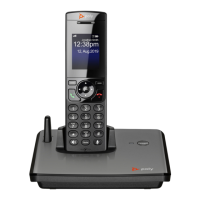Call Routing
36
the number used for matching call routing rules has already incurred the transformations, if any, implied by
the digit map. Remember this fact when crafting your own OutboundCallRoute.
OutboundCallRoute Examples
sp1 OR {SP1} OR {:SP1} OR {@:Sp1} (all equivalent)
This rule says: Make all calls using the SP1 Service, without any caller-id spoofing or digit transformation.
{(Mpli):pli},{(<**1:>(Msp1)):sp1},{(<**2:>(Msp2)):sp2},{(<**8:>(Mli)):li},{(<*
*9:>(Mpp)):pp}
This is the default OutboundCallRoute for the handset. It says:
● Dial *** to invoke the local device configuration IVR.
● (Mpli) and pli are substituted with the PrimaryLine’s abbreviated name.
● Use SP1 Service to call all numbers that start with **1 and subsequent digits matching SP1 Service’s
DigitMap. Remove the **1 prefix from the resulting number before making the call.
● Use SP2 Service to call all numbers that start with **2 and subsequent digits matching SP2 Service’s
DigitMap. Remove the **2 prefix from the resulting number before making the call.
● Use the OBiTALK Service to call all numbers that start with **9 and subsequent digits matching
OBiTALK Service’s DigitMap. Remove the **9 prefix from the resulting number before making the
call.
Digit Map Configuration
A digit map serves to transform and restrict the number that can be dialed or called, and determine if you
dialed sufficient digits to form a complete number. Each map is composed of one or more rules surrounded
by parentheses (which MUST NOT be omitted). Here is the general format of a digit map:
(rule|rule|….|rule)
A digit map rule is a rule for matching a given sequence of digits. It can contain extra white spaces for
readability. All spaces are removed by the device during parsing. A rule can contain one or more of the
following elements:
● literals – Any combination of 0-9,*,#,+,-,A-Z,a-z, except m, M, s, S, x, X, which have special
meaning in the digit map syntax. It matches digit sequences with exactly the same literals.
● ‘literals’ – Everything inside a pair of single quotes is treated as a literal except for the single
quote (‘) character.
● x – a wild card digit that matches any digit from 0-9. x is case-sensitive.
● x. – matches 0 or more x.
● [123-7] or [135] – A set of 1 or more digits surrounded by pair of [ ]. It matches any digit in the
set. The – syntax represents an inclusive digit range, such as 0–9, 3–7. So [123–7] is equivalent
to [1–7] or [1234567].
● S, S0, S1, S2, …S9 – Digit timer of 0, 1, 2, …,9 seconds. S is equivalent to S1. S0 is the same as
“blank”. You can concatenate multiple S elements together if you need more than 9 seconds timeout,
such as S9S5 for a 14-second timeout. S is case-sensitive. It should only be used either as the first
element of a rule for hot/warm line implementation, or as the last element of a rule as a means of
overriding the default interdigit timer.

